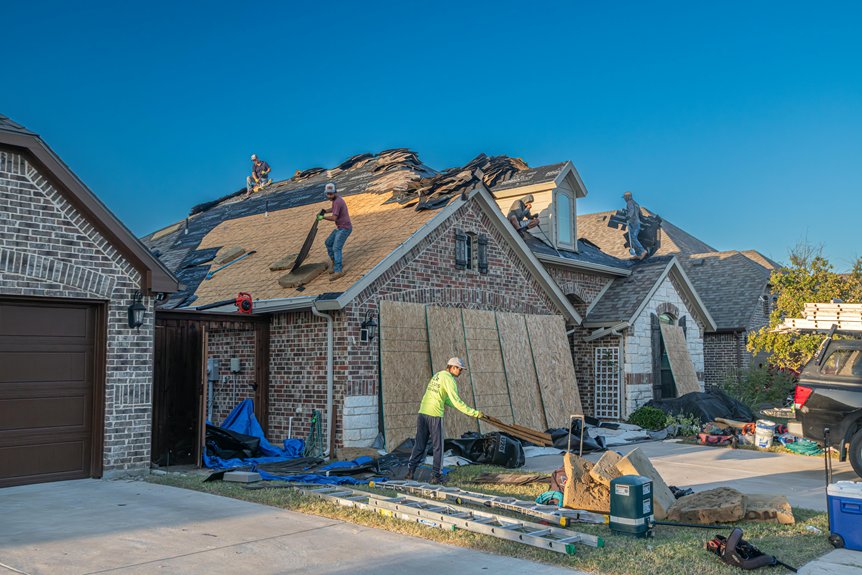Replacing your roof can be a significant project, and ensuring safety should be your top priority. From preparing your work area to handling materials properly, every step matters. Proper precautions can prevent accidents and keep the job on track. But knowing what safety measures to take isn’t always straightforward. Keep these essential tips in mind to protect yourself—after all, a safe process leads to a successful roof replacement.
Assess and Prepare Your Work Area Safely
Before starting your roof replacement, it’s essential to evaluate and prepare your work area to guarantee safety. Begin by clearing the area of debris, furniture, and any obstacles that could cause trips or falls. Ensuring proper area clearance helps create a safer environment for you and anyone nearby.
Next, organize your tools and materials by storing them securely in designated tool storage, preventing accidental slips or drops. Keep walkways free of clutter and make sure the ground is stable.
Checking the workspace beforehand minimizes hazards and allows you to work efficiently. Remember, a clean, organized work area not only enhances safety but also helps you complete the job more smoothly and effectively. Proper preparation is a vital first step in any roofing project, especially when considering storm damage roof repair or other emergency services.
Use Proper Personal Protective Equipment (PPE)
Having your work area organized and clear is just the first step; wearing the right personal protective equipment (PPE) is essential to stay safe during your roof replacement.
Proper footwear provides essential grip and stability, reducing the risk of slips and falls. Sturdy boots with non-slip soles help keep you secure on uneven or sloped surfaces.
Eye protection is equally important, guarding against dust, debris, and any accidental splashes or flying particles. Safety glasses or goggles shield your eyes from potential hazards, ensuring clear vision while working.
Always choose PPE designed for roofing tasks, and double-check that it fits well.
Using the correct PPE minimizes injuries and makes your roofing project safer and more efficient.
Ensure Safe Ladder and Scaffold Use
To prevent falls and accidents, it’s essential to use ladders and scaffolds correctly. Ensure ladder stability by placing it on level, solid ground and securing it if necessary. Always maintain three points of contact when climbing and avoid leaning sideways.
Before using scaffolds, perform a thorough scaffold inspection to check for damaged parts, loose fittings, or unstable bases. Make sure the scaffold is properly assembled and anchored to prevent tipping.
Never overload scaffolds beyond their weight capacity, and keep all platforms free of debris and tools. Properly securing ladders and inspecting scaffolds regularly help prevent slips, falls, and structural failures.
Taking these safety steps keeps you safe while working at heights during your roof replacement.
Handle Materials Safely and Securely
Handling roofing materials safely and securely is essential to prevent injuries and damage. Proper material handling involves lifting with your legs, not your back, and avoiding sudden movements that could cause slips or falls.
Always use gloves and safety gear to protect your hands and skin from sharp edges or rough surfaces. Secure storage of materials on the roof or nearby guarantees they won’t slide or fall, creating hazards for you or others.
When moving materials, communicate clearly with anyone assisting you to coordinate efforts and prevent accidents. Keep walkways clear of debris and tools to avoid tripping.
Regularly inspect your storage areas to make sure materials stay stable and secure. Staying attentive to material handling and secure storage keeps your roof replacement project safe and efficient.
Be Mindful of Weather Conditions
Monitoring weather conditions is vital as you work on your roof. Sudden weather hazards like rain, strong winds, or snow can create dangerous conditions and compromise safety. Check the forecast regularly and plan your work during clear, calm days.
Seasonal timing matters too; avoid roofing projects during storm seasons or extreme heat, which can cause heat exhaustion or slip hazards. Be especially cautious of wind gusts that could knock you off balance or dislodge tools and materials.
If the weather looks unpredictable, it’s better to pause your project and wait for safer conditions. Staying aware of weather patterns helps prevent accidents and guarantees your roof replacement proceeds smoothly and safely.
Always prioritize your safety over deadline pressures.
Know When to Call in Professional Help
Knowing when to call in professional help is essential for ensuring your safety and the quality of your roof replacement. If you’re unsure about choosing the right contractor, it’s wise to seek experienced professionals who can deliver reliable results.
Don’t attempt complex repairs or work on steep or damaged roofs alone; these tasks pose significant risks.
Additionally, understanding warranty coverage is vital—if issues arise later, a reputable contractor can handle repairs under the warranty, saving you time and money.
Recognize your limits, especially if you encounter structural problems, extensive damage, or unsafe conditions.
When in doubt, consulting a licensed roofing expert guarantees the job is done correctly and safely, giving you peace of mind and a durable roof.
Conclusion
By following these safety tips, you can protect yourself and ensure a smooth roof replacement. Always assess your work area, wear the appropriate personal protective equipment (PPE), and use ladders and scaffolds correctly. Handle materials carefully and stay alert to weather conditions. Remember, if you’re unsure or the job seems too risky, don’t hesitate to call in professionals. Prioritizing safety will help you complete your project confidently and without accidents. For more information on how to schedule your free roof inspection, call us at (405) 543-2920 or visit us online at Top View Roofing.











